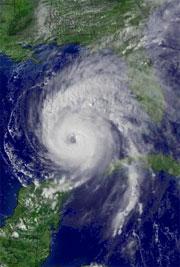 Hurricanes whip up not just water, but sand too.© NOAA
Hurricanes whip up not just water, but sand too.© NOAAHurricanes whip up gigantic waves at sea, but it seems they could also cause even more dangerous monsters to crash into shore.
Researchers at the US Naval Research Laboratory, based at the Stennis Space Center in Mississippi, think that hurricanes can pile up sediment underwater that could then slip, causing a tsunami. The team points to geological evidence for unexplained landslides in the Gulf of Mexico thousands of years ago, one of which is thought to have created a wave more than 15 metres high that smashed into the coast of Texas.
William Teague and his colleagues have a history of studying hurricane waves. Last year they reported that Hurricane Ivan, which caused massive damage in Grenada, Jamaica, Florida and Alabama in 2004, created waves about 40 metres high (see 'Hurricanes whip up huge waves').
That's much higher than the tsunamis the researchers think such hurricanes might produce — but tsunamis wreak much more damage onshore. The 2004 tsunami in the Indian Ocean was about 18 metres high when it struck the shoreline nearest to its epicentre.
“A tsunami surge would cause enormous damage.”
William Teague,
Naval Research Laboratory, Stennis Space Center, Mississippi.
Tsunamis are generated by abrupt ructions of the sea floor, usually earthquakes or underwater landslides. "There have been documented cases of landslides triggering tsunamis," Teague says. Studying Hurricane Ivan has persuaded him and his colleagues that hurricanes could also provoke massive landslides in marine sediments.
Swept away
The researchers moored six batches of instruments for measuring water depth, pressure and currents on the seabed in Hurricane Ivan's path. At two of these spots, the storm scoured about 30 centimetres of sediment from the sea floor. "All of the moorings were deeper immediately after the passage of Ivan," says Teague.
The hurricane caused an underwater sandstorm, they report in Geophysical Research Letters1. Although the instruments had metal casings, sand and silt got into one of them, clogging it up.
From the amount of sediment moved at each site, the team estimate that Ivan stirred up more than 100 million cubic metres of sandy material. They say that some of this would have been dumped close to land, on the continental shelf near the Mississippi Delta.
If such a pile gets too big it might collapse, triggering a tsunami.
But there's no need to panic. "We are just suggesting that hurricanes could be a potential trigger," says Teague. "Fortunately this has not happened very often, if ever."
Even so, it's a threat worth considering. "A tsunami surge would cause enormous damage, far beyond that caused by Hurricane Katrina," Teague warns. "And a slump event could do lots of damage to offshore oil and gas facilities."
Ancient waves
ADVERTISEMENT
The team points to geological evidence for an underwater slump between 5,000 and 10,000 years ago off the coast of Mexico that is estimated to have caused a 7.6-metre-high tsunami. And even longer ago, a slump near the Mississippi Delta caused a wave probably at least twice as big to hit shore.
It's not known what caused these underwater landslides. The usual suspects are earthquakes, but the Gulf of Mexico is not seismically active. So Teague and colleagues think that ancient hurricanes may have been responsible. If that's true, there's no reason why it wouldn't happen again, they say.
Visit our couldcause_tsunami.html">newsblog to read and post comments about this story.
Naval Research Laboratory, Stennis Space Center, Mississippi.
